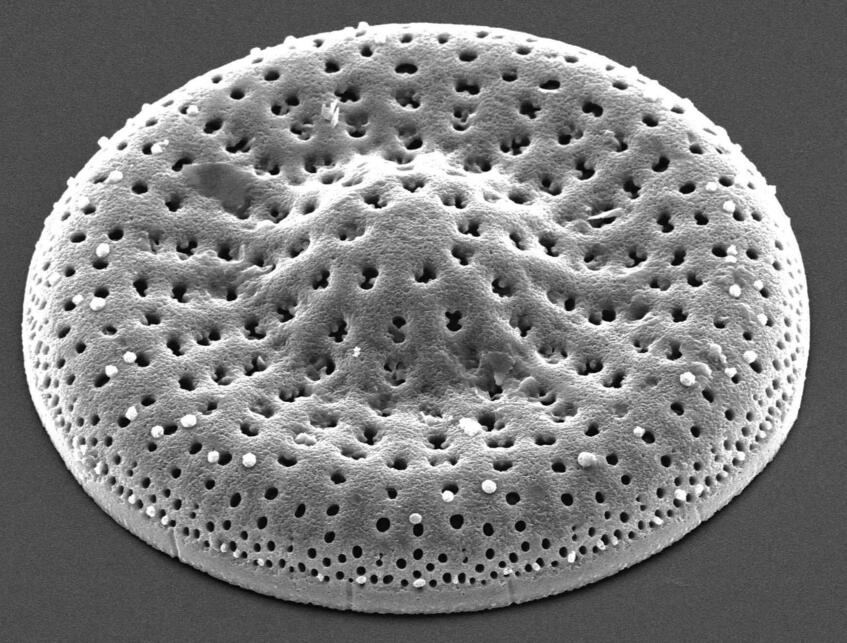Bulletin of the Geological Survey of Japan Top Page
Bulletin of the Geological Survey of Japan Vol.72 No.6 (2021)
Cover photograph | Table of Contents | Abstract
Cover Figure
Scanning microphotograph of Mesodictyon japonicum Yanagisawa & H.Tanaka, a fossil diatom
Mesodictyon japonicum Yanagisawa & H.Tanaka is a freshwater lacustrine planktonic diatom described from upper Miocene marine strata. The possibility of marine species was initially nsuspected because it was successively reported from marine strata in Niigata, Akita and Ibaraki prefectures. However, it was later identified as freshwater by the discovery of the same species in freshwater caldera lake sediments in Fukushima Prefecture, and the valves in the marine sediments are confirmed to be allochthonous fossils transported from inland lakes to the sea through rivers. The photo is a specimen (16 μm in diameter) from the lower Pliocene marine deposits of the Tentokuji Formation in Daisen City, Akita Prefecture, Japan. The paper in this issue reports M. japonicum from the upper Miocene marine deposits of the Shitazaki and Kubo formations distributed in the Ninohe area (Iwate Prefecture) and Sannohe area (Aomori Prefecture). The fossil evidence accumulated in biostratigraphic studies to date indicates that the first occurrence of M. japonicum in Japan is confined to a relatively narrow range of 8.2–8.7 Ma, and this isochroneity implies the possibility of biostratigrahic utilization of this diatom biohorizon.
(Photogarph by TANAKA Hiroyuki and caption by YANAGISAWA Yukio)
Table of Contents
All the pages PDF : 72_06_full.pdf [14MB]
| Title | Author | |
|---|---|---|
| Article | ||
| Diatom biochronology of the horizon of warm water calcareous microfossils in the upper Miocene Funakawa Formation distributed in Shimo-arakawa, Daisen City, Akita Prefecture, Japan | YANAGISAWA Yukio (p459-477) | 72_06_01.pdf[3.3MB] |
| Fossil freshwater centric diatom Mesodictyon japonicum Yanagisawa & H.Tanaka from the upper Miocene marine deposits distributed in the Ninohe-Sannohe area, near the boundary between Iwate and Aomori prefectures, Northeast Japan | YANAGISAWA Yukio (p479-493) | 72_06_02.pdf [3MB] |
Abstract
Diatom biochronology of the horizon of warm water calcareous microfossils in the upper Miocene Funakawa Formation distributed in Shimo-arakawa, Daisen City, Akita Prefecture, Japan
YANAGISAWA Yukio
The paleoceanic environment of the Japan Sea during the middle to late Miocene has been previously considered to be dominated by cold water masses. However, calcareous microfossil data indicate the presence of short-term warm periods with intermittent warm current inflows into the Japan Sea during this period. One of evidence for this short-term warm period is provided by planktonic foraminifera and calcareous nannofossils from the Funakawa Formation in Shimo-arakawa, Daisen City, Akita Prefecture. Diatom chronostratigraphic analysis of this study confirms that this warm-water calcareous microfossil assemblage can be assigned near the upper limit of the diatom zone NPD6A at ca 8.7 Ma. The occurrence of warm-water diatoms shows that this warm period corresponds to the interval from the uppermost NPD6A to the lowermost NPD6B, and roughly correlated to the O-1 assemblage, which is one of the calcareous foraminiferal assemblages including warm-water species in the Japan Sea. This suggests that weak warm currents flowed from the Pacific Ocean side into the Japan Sea, where cold surface water was dominant at that time.
Fossil freshwater centric diatom Mesodictyon japonicum Yanagisawa & H.Tanaka from the upper Miocene marine deposits distributed in the Ninohe-Sannohe area, near the boundary between Iwate and Aomori prefectures, Northeast Japan
YANAGISAWA Yukio
Modern freshwater planktonic diatom assemblages appeared near the middle/late Miocene boundary when the nonmarine Actinocyclus was replaced by the genera of the family Stephanodiscaceae. The genus Mesodictyon was a frontier that first entered the lake environment in this turnover among the family Stephanodiscaceae. In this study, Mesodictyon japonicum Yanagisawa & H.Tanaka, an important constituent of late Miocene lacustrine planktonic diatom assemblage in Japan, is reported from the Neogene marine deposits of the Shitazaki and Kubo formations distributed in the Ninohe City (Iwate Prefecture) and Sannohe Town (Aomori Prefecture). The first occurrence of this species was recognized in the lower part of the diatom zone NPD6B (Thalassionema schraderi Zone) and was dated at ca. 8.3 Ma. Fossil evidence from this study and previous researches in Japan indicates that the first occurrence of M. japonicum in Japan is confined within relatively limited time range of 8.2–8.7 Ma, implying possible isochroneity of this diatom biohorizon. Mesodictyon japonicum seems to appear in geological record at around 8.6–8.7 Ma near the base of the NPD6B.
Geological Survey of Japan, AIST
- About GSJ
- Our Activities
- Purchase guide
-
Publications and Database
- information
- Bulletin of the Geological Survey of Japan
- bull2025(Vol.76)
- bull2024(Vol.75)
- bull2023(Vol.74)
- bull2022(Vol.73)
- bull2021(Vol.72)
- bull2020(Vol.71)
- bull2019(Vol.70)
- bull2018(Vol.69)
- bull2017(Vol.68)
- bull2016(Vol.67)
- bull2015(Vol.66)
- bull2014(Vol.65)
- bull2013(Vol.64)
- bull2012(Vol.63)
- bull2011(Vol.62)
- bull2010(Vol.61)
- bull2009(Vol.60)
- bull2008(Vol.59)
- bull2007(Vol.58)
- bull2006(Vol.57)
- bull2005(Vol.56)
- bull2004(Vol.55)
- bull2003(Vol.54)
- bull2002(Vol.53)
- bull2001(Vol.52)
- Bulletin of the Geological Survey of Japan(old)
- Annual Report on Active Fault and Paleoearthquake Researches
- Reports, Geological Survey of Japan
- CCOP-GSJ Groundwater Project Report
- CCOP Technical Bulletin
- Cruise Report
- Geological Hazards
- Learning and Education
- GSJ Database Collection
- Collection of links


